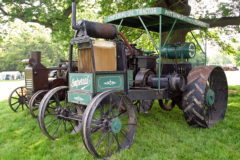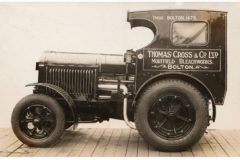Buying a Ford Series 10 Force II
Posted by Chris Graham on 31st May 2020
The Ford Series 10 Force II tractor range may represent a bit of a mouthful but, in practice, these tractors are very desirable machines. Chris Graham explains how to bag yourself a good one.
Photographs: Tractor Barn Productions (tractorbarnproductions.com)
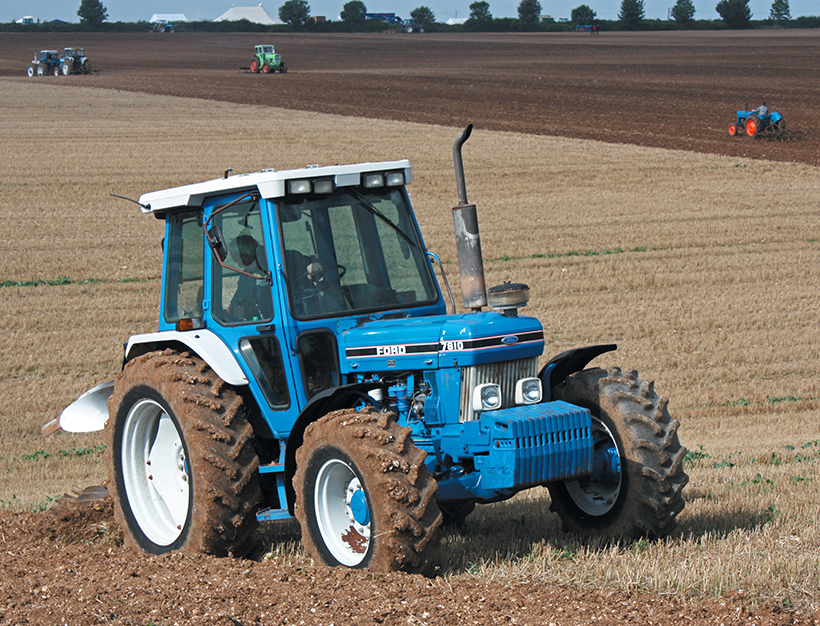
Buying a Ford Series 10 Force II: This model range remains a very capable tractor. This is one of the most popular models, the relatively light and powerful, six-cylinder 7810, in this case with four-wheel-drive.
Wind the clock back to the early 1980s and you’ll find yourself in an influential time for Ford and its tractors. While the great and the good were grappling with big hair, Spandex and shoulder pads, the boffins at Basildon were set to release the Series 10 tractor upon the world.
Replacing the 600 and 700s, the Series 10 – launched in September, 1981 – ushered in a more powerful, more modern and more productive range of machines that helped propel Ford tractors into a new age. But, apart from the smarter more up-to-date styling and the power hikes from stronger engines, it was the luxury of the first-ever synchromesh transmission that really caught the attention.
Unfortunately, the SynchroShift system – which helped to de-clutter the cab by moving the control levels from the floor to the steering column – wasn’t the greatest to use, in practice. It quickly developed a reputation for being awkward and cumbersome, and the difficulty that some found with gear selection led to it being referred to as the ‘Rubik’s Cube’ gearbox – a reference to the notoriously difficult puzzle that was all the rage at the time. That name stuck and you’ll still hear it used today.
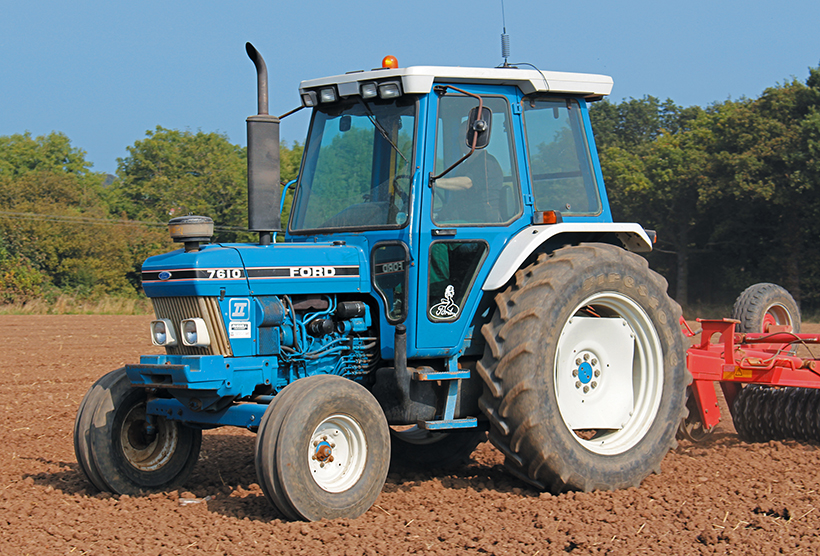
This two-wheel-drive 7610, with its Super Q cab, produced nearly 100hp from its four-cylinder engine. The cab featured four work lights mounted in the front of the roof (and two at the back) as standard, and the air filters mounted externally on both sides, towards the rear.
Conventional changes
The 6710 and 7710 models weren’t saddled with SynchroShift, and retained a conventional, floor-mounted gear selector operating through a standard, H-pattern gate. As a consequence, these models became popular sellers. The 8210, complete with 115hp, six-cylinder, 6.5-litre engine, arrived in 1982 to complement the existing three- and four-cylinder-powered models, and brought with it four-wheel-drive, thanks to a ZF front axle. While most models got Ford’s excellent Q cab, the three-cylinder machines were offered with a new, low profile (LP) cab produced by Danish specialist, Sekura. An ‘all-purpose’ (AP) cab version from the same source followed in 1984, and proved popular with those on tighter budgets.
However, it was in 1985 that things got even more interesting, when Ford decided to rejuvenate the whole Series 10 range by introducing the Force II variants. By smartly using the ‘Force’ name to link back to the dramatic improvements made to the 1000 Series in the late 1960s, Ford also chose this moment to introduce the Super Q cab (on all but three-cylinder models); a night-and-day improvement over the previous cab options, and one that catapulted the Force II to new levels of both desirability and popularity.
In conjunction with this, the Force II also dealt with ‘Rubikgate’ by returning to traditional, floor-mounted transmission controls, and all seemed well with the world. One other notable event in the Force II timeline occurred in 1978, when Ford introduced the 7810 model, which offered 100hp, six-cylinder power in a lighter package than the similarly-powered 7910. The Force II models were replaced by the Generation III in 1989, and production of the Series 10 ended in 1991.

The 4610 was powered by a three-cylinder engine developing 60hp, and is seen here fitted with a Sekura all-purpose (AP) cab.
Appreciating asset
Today, the Series 10 market is starting to warm up, with sale prices on a gradual rise, and these models starting to enjoy a solid following among tractor enthusiasts, old and new. So now could well be a good time to bag yourself a decent example and, with that in mind, I consulted FFA Lincolnshire rep and proprietor of GC Agricultural (tel: 07879 002584), Gary Capp. He has plenty of direct experience of owning and repairing Series 10 models, so is ideally placed comment knowledgeably on the dos and don’ts of buying.
The first point he made was that, with so many models in the range, there’s plenty of choice and something for everyone, whether you want three-, four- or six-cylinder power, something handy for light use and showing, or a bigger, more powerful machine for serious fieldwork. Despite getting on for 40 years old, the Series 10 stull represents a perfectly serviceable and usable tractor and, in the right spec, is more than capable of putting in a good day’s work.
“The real thing that really made a big difference with this model – both to its functionality as a tractor when new, and to its desirability now – was the arrival of the Super Q cab,” Gary told me. The Series 10 itself was a decent enough machine and was certainly a popular seller for Ford, but the new cab that arrived with the Force II variant featured here, made a big difference. It provided a much better, more comfortable working environment for the driver, with more effective sound-deadening, a flat floor and – thankfully – the replacement of the ‘Rubik’s Cube’ gear selection system, which was like stirring a rice pudding!
“However, good though the Super Q cab was, nowadays it probably represents the biggest potential problem associated with buying a Series 10 Force II today. This cab was designed to provide roll-over protection for the driver but, in many cases, the intervening decades have highlighted weaknesses in the metal and paint used, which result in corrosion. Consequently, buyers should check carefully along the bottom edges of all the windows (especially the front screen and doors) for signs of rust, bubbling paint or botched repairs. Plenty that I’ve seen have been badly repaired with filler by those looking for a cheap fix or a quick sale. Putting this sort of damage right, using proper repair sections, is time-consuming, expensive work, so be warned.”
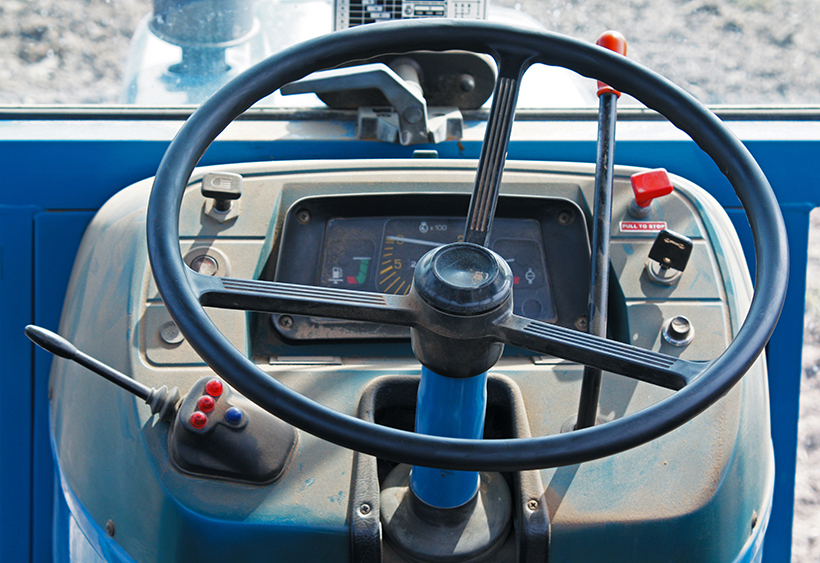
The dash layout on the Series 10 Force II is simple and, thankfully, drivers don’t have to wrestle with the column-mounted SynchroShift gear change mechanism.
Durable machines
Being an accomplished performer means that Series 10 tractors can wear their age well, so it’s always a good idea to take somebody with you who knows what they’re looking at when viewing a prospective purchase. While these tractors aren’t worth a fortune so the initial outlay isn’t likely to be massive, there’s still little point in rushing out and unnecessarily buying yourself a whole heap of trouble. It’s common sense to buy the best example you can find, but it’s equally smart to have a calming influence with you during the inspection, to curb your enthusiasm and point out the realities of what you might be letting yourself in for. A friend with relevant ownership/restoration experience could save you thousands of pounds – and hours of frustration – further down the line.
All the common-sense rules about service and working history apply, too, so always find out as much as you can before parting with any cash. “The ways in which a tractor has been used and maintained are key factors,” Gary added. Of course, it’s not always possible to get this information but, if it is, then do so. Obviously, you should check the hours total, and make sure that the meter is still actually working. Also, bear in mind that a vehicle showing a low total may have been around the clock once, despite what the salesman/owner might be telling you! So, pay attention to factors such as the wear levels on the seat and – especially – the clutch pedal. If the latter is worn smooth, then the tractor will have led a long and hard life.”
Mechanically speaking, the situation is generally relatively encouraging. While the porous block problem was yet to be properly resolved by Ford, mechanical reliability across the Series 10 Force II range is pretty good. Nevertheless, you should always be sure to check the condition of the engine oil. Any block defect-related mixing between it and the coolant solution will present a greyish-coloured, mayonnaise-like concoction, at which point you’d be best to walk away unless the tractor is being offered at a bargain price. The same condition can also be indicated starting difficulties; if the engine doesn’t fire and run after four or five turns, then the alarm bells should start ringing.
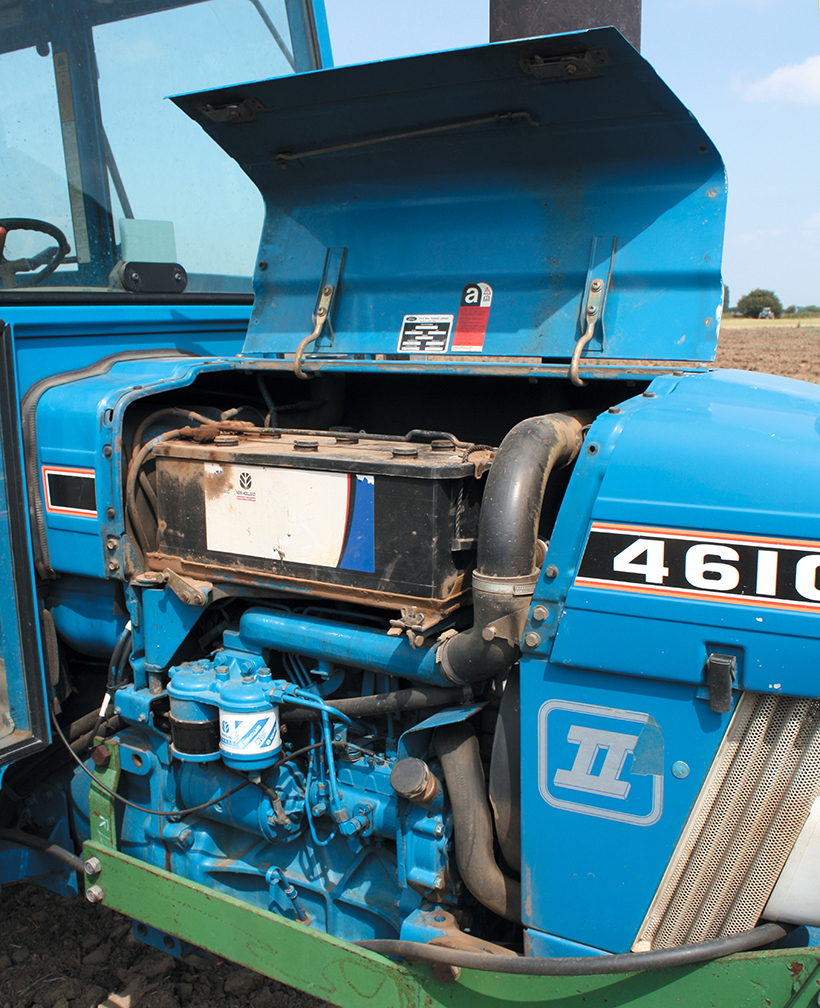
The battery is housed conventionally, under a hinged bonnet panel.
Smooth-shifting?
When carrying out a pre-purchase inspection, take time to check that the operation of the transmission is smooth and efficient. Gary says: “Gearboxes on Gen II tractors can suffer with dry cross shafts on the selector mechanism which then, if forced, can pop the nylon bushes out of their housings, leaving it impossible to select any gear at all. This problem was rectified on the Generation III Series 10, when Ford added a grease nipple so that the shafts could be kept lubricated as part of the routine servicing schedule.”
The electrics on these tractors are straightforward and reliable, overall. However, it’s worth checking the condition of the connectors where the wiring loom leaves the cab, and heads for the engine. These aren’t of the greatest quality, so can suffer with water and dirt ingress, which obviously affects their consistency of performance. Replacements, though, are readily available.
The braking system is generally reliable, too. It’s a simple, rod-based set-up, with phosphor-bronze brake discs with rear axle. Check the pedal travel to assess for wear and adjustment and, once again, be aware that badly worn or poorly adjusted brakes point to hard use and/or neglect. At the front of the tractor, check the condition of the track rods, kingpins and wheel bearings for wear and play. Ideally, you’ll need to get the fronted end lifted on a jack to assess these aspects effectively.
The back axle can leak oil due to worn oil seals and bearings, but this is usually fairly obvious as you’ll see the associated dampness on the housing. The rear axle is fed with fluid by the transmission, so it’s important that leaks are dealt with. The transmission fluid is something that many owners will have ignored down the years. The service requirement is to change it after every 600 hours of operation but, in Gary’s experience, this was regularly skipped in a great many cases. Engine oil, which should be changed every 250 hours, gets similarly neglected, as does coolant.
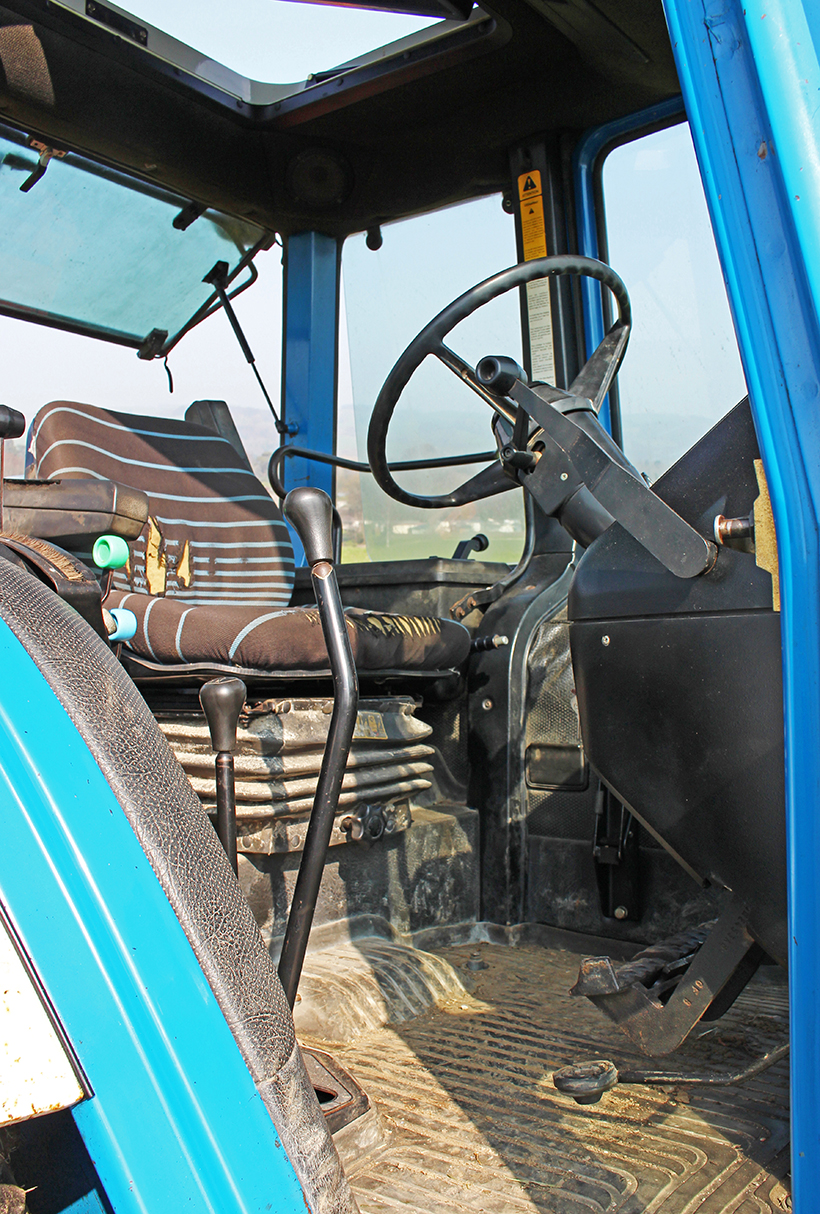
The Super Q cab’s flat floor, superior sound insulation, opening windows and floor-mounted gear level were all much appreciated by Series 10 Force II model owners.
Effective cooling?
With regard to coolant, Gary explained: “Ford added a coolant filter on the generation III Series 10 machines, but the IIs didn’t benefit from this extra line of defence. It’s unfortunately common for previous owners to have skimped on the use of anti-freeze and coolant additives, preferring the cheaper option of plain water. While this will, of course, keep the engine cool, it’ll also promote internal rusting. So, if you discover rust-coloured coolant in a prospective purchase, then this is another, tell-tale sign of penny-pinching neglect. Such details are the sort of factors which should cause you to think twice about any machine.”
On the face of it, then, this generation of Series 10 should be a relatively straightforward tractor to buy. There are good numbers out there, prices are still affordable and, given the machine’s lack of electronic complexity, putting problems right shouldn’t pose many expensive problems. The one exception to that is the Super Q cab which, if badly rusted, will need to be removed for effective repair, and that process will cost several thousand pounds if entrusted to a specialist.
The spare parts situation generally is still pretty good, although Gary told me that it’s no longer possible to buy a new, replacement engine. However, there’s a good supply of new and used mechanical parts on the market, so most engine-related issues can be dealt with. “One thing to be wary of, though,” Gary added, “is the ever-increasing number of non-genuine parts finding their way on to the market. Many of which originate from countries like India, and there can be dramatic variations in quality. My advice would be to stick to genuine Ford parts whenever possible; you’ll pay a bit more, but everything will be fit for purpose.
“Finally, just a word of warning about being sure what you’re buying. The growing demand for Series 10 models means that people are being tempted to import models from the Continent to sell-on here. I’ve come across several sellers of imported, Belgian-made models being a little economical with the truth, and claiming they’re selling UK-spec tractors when they’re not.
“Unsuspecting buyers, who don’t know to check the maker’s plate, can be tempted into paying an over-the-top price for what’s likely to a poorly-specified European import. The spec differences are quite detailed but, to be sure, the tractor’s under-bonnet manufacturing number needs to be checked. If it starts with a ‘B’, then it’s a Basildon-built machine but, if the number is prefixed by an ‘A’, then the tractor was built at Ford’s Antwerp plant.”

Buy a down-at-heel example like this 7810 and you must be prepared to spend a few thousand sorting it out. Note the rusting immediately under the windscreen – that’s common for the Super Q cab, I’m afraid.
What to pay
The cheapest Series 10 Force IIs around these days are likely to cost you about £4,000, for which you’ll get a ropey example that’s in need of a lot of work to bring it back to full and presentable working order.
For a typical, reasonably presentable example in decent running order, you should expect to pay about £8,000. However, it’s important to appreciate that, even at this price, these machines are still likely to need a significant investment to bring them up to scratch. Ideally, any new owner contemplating a down-at-heel Force II Series 10 should set aside a £5,000 ‘war chest’ of money to fund what’s likely to need doing.
With these models now starting to appreciate and interest growing, the demand for good, genuine spare parts is getting stronger, too, which increases the temptation to break tractors for the parts, which is a sad fate.
One of the most popular models in the range is the six-cylinder, 100hp 7810, and decent examples are currently selling for £12,000-£15,000.
SERIES 10 TECH SPECS
| Model | Built | No. cyl. | Bore | Stroke | HP | CC |
| 2310 | 1988 – 1991 | 3 | 106.7 | 96.5 | 34 | 2,590 |
| 26/2910 | 1988 – 1991 | 3 | 106.7 | 106.7 | 40 | 2,868 |
| 36/3910 | 1988 – 1991 | 3 | 111-8 | 106.7 | 47 | 3,147 |
| 4110 | 1988 – 1991 | 3 | 111.8 | 111.8 | 54 | 3,294 |
| 4610 | 1988 – 1991 | 3 | 111.8 | 118.8 | 60 | 3,294 |
| 56/5710 | 1988 – 1991 | 4 | 111.8 | 106.7 | 68 | 4,193 |
| 6410 | 1989 – 1991 | 4 | 111.8 | 118.8 | 80 | 4,392 |
| 66/6710 | 1981 – 1989 | 4 | 111.8 | 111.8 | 78 | 4,392 |
| 6810 | 1989 – 1991 | 4 | 111.8 | 111.8 | 90 | 4,392 |
| 76/7710 | 1981 – 1991 | 4 | 111.8 | 111.8 | 95/97 | 4,392 |
| 7810 | 1987 – 1991 | 6 | 111.8 | 111.8 | 100 | 6,571 |
| 7910 | 1984 – 1991 | 6 | 111.8 | 111.8 | 98 | 6,571 |
| 8210 | 1982 – 1991 | 6 | 111.8 | 118.8 | 115 | 6,571 |
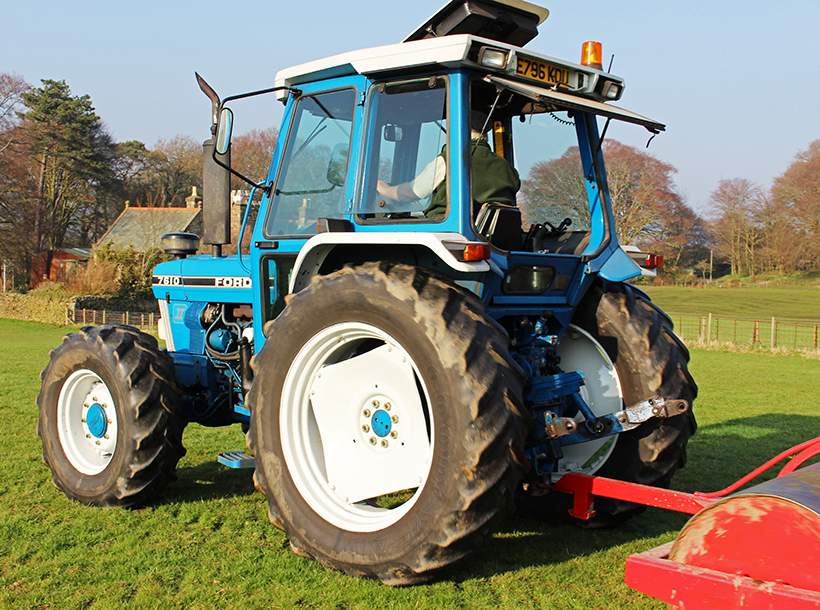
Corrosion can strike around the indicator light units, which sit on the narrow wings. Dirt collects around and under them, traps moisture and the resultant rust can spread across into the cab structure. Check the trailer hitch; these can wear badly with excessive use.
To subscribe to Ford & Fordson Tractors magazine, simply click here



